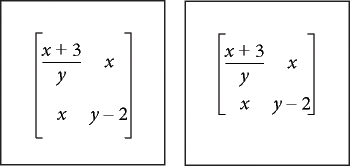You can change the number of rows or columns in a matrix and add or remove brackets around the matrix. You can allow the column width to vary from column to column, depending on the contents, or specify that all columns are equal width. Similarly, you can allow the row height to vary from row to row.
You can also transpose a matrix and perform matrix algebra.
-
To add a row or column to a matrix, place the insertion point in the matrix. On the Matrices page of the Equations panel, choose Add Row or Add Column from the Matrix Commands drop-down list.
Before Add Column
After Add Column


Add Row adds a row at the bottom.
Add Column adds a column at the far right.
-
To delete a row or column from a matrix, select the row or column and press Delete.
-
To add or remove brackets around a matrix, select the entire matrix. On the Matrices page of the Equations panel, click Add/Remove Brackets.
-
To change the row height or column width in a matrix, select the matrix. On the Matrices page of the Equations panel, choose All Equal or Proportional from the Matrix Row Height or Matrix Column Width drop-down list.

If you choose Proportional, each row is tall enough to hold the tallest cell in the row. Each column is wide enough to hold the widest cell in the column.
If you choose All Equal, each row is tall enough to hold the tallest cell in the entire matrix. Each column is wide enough to hold the widest cell in the entire matrix.